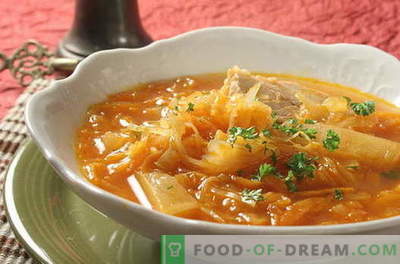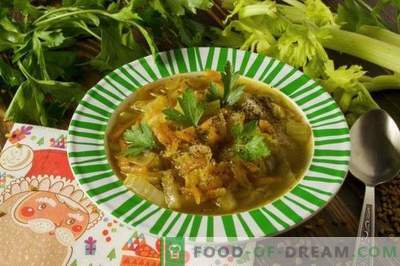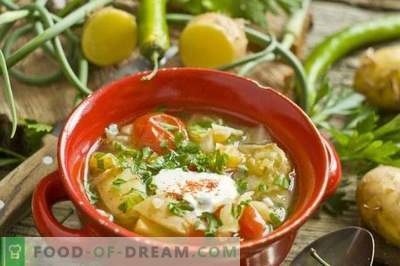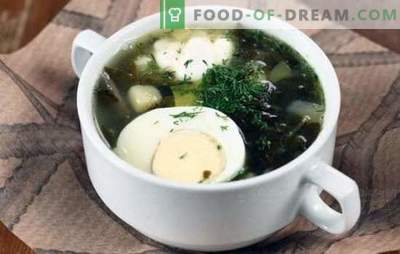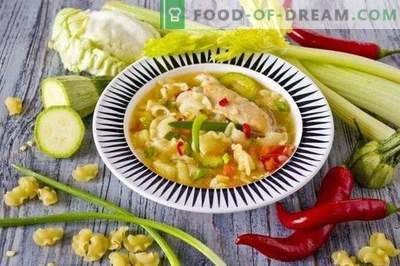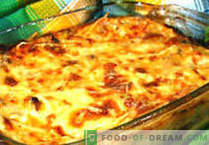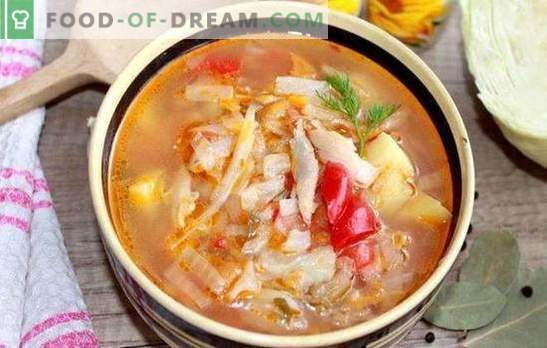
Almost all of the past millennium is with cabbage soup and porridge, as popular wisdom says, as chroniclers and historians say. Maybe this is a great exaggeration, but the history of Russian cuisine does not know any other popular long-livers, except bread and all kinds of pies. Kvasy, kissels while we leave aside. Let's talk, for example, about fresh cabbage soup with chicken.
Such a choice is not accidental. Of course, the soup of beef brisket and sauerkraut in various variations, even in the view of foreign tourists, is an immutable classic of Russian cuisine, but in the end you want at least some kind of diversity over a thousand years!
Chicken meat - anti-crisis, nutritional and dietary option for soup. This is the first. In the modern kitchen, with the latest technical capabilities, you can afford to dream and expand the culinary horizons. This is the second. Of course, we will not back down from the basic principles by which ordinary soup with cabbage can be distinguished from real soup, out of a sense of patriotism and to preserve Russian culinary traditions.
Fresh cabbage soup with chicken - the main technological moments
For a start - briefly about the ingredients that may consist of soup. Surprisingly, the fact remains: very simple soup, not as simple as it seems at first glance. It is enough to look at the composition of ingredients for cabbage soup in two or three antique cookbooks, as is evident: soup can consist of everything that at the time of their preparation will be at hand, as in the Russian fairy tale about porridge made from an ax.
But, despite all the variety of components, the basic composition of ingredients for the cabbage soup is strictly regulated by traditions and special cooking technology, typical only of Russian cuisine. The composition of the ingredients is important, as well as the technology of cooking the first dish.
Russian soup is, necessarily, cabbage or other green mass, replacing it. Without cabbage, sorrel, nettle or other green mass, rich in vitamin C, on the table - anything, but not soup. But, if in the first dish there is cabbage and root of the beet, for example, then this is borsch, but the leaves of this vegetable, rich in fiber, are allowed to be added to the soup. Traditional cabbage soup is made from sauerkraut or sorrel, as these ingredients give the dish a distinctive sour taste. Fresh cabbage also has a valuable mineral and vitamin composition, but there are not enough organic elements in it, which form the sour taste of soup.
Therefore, when using fresh cabbage for crouting an acid, the dish is given with the help of the second essential ingredient - sour dressing.
The role of sour dressing and, at the same time, filling in traditional soup is fulfilled by sour cream.
Why sour cream? Maybe because it is just tasty and beautiful, and maybe because our distant ancestors intuitively chose this product to replace cabbage pickle, which also contains lactic acid, and has a very positive effect on digestive processes, since it is not inferior in content to probiotics dietary kefir. Tomato as part of the cabbage soup appeared as an acidic dressing much later, mainly in the southern regions of Russia, from where it began to be developed as an agricultural crop. In the absence of tomatoes, besides dressing from cabbage pickle, sour cream, apples, grated sour-berry puree were used for summer cabbage soup from fresh cabbage.
In addition to cabbage and sour dressing, broth or at least water is necessary for the cabbage soup.
Immediately we denote the volume of the liquid: in the case, the ratio of solid and liquid ingredients should be approximately the same, according to modern standards, and popular wisdom says that soup should be like “so that the spoon stands”. Choose the consistency you want.
Broth can be made from any meat or fish, or several types of meat or fish, or meat and fish together. These products were put into the boiler in different ways. Pork, lamb, beef and large game meat were cooked in large pieces to a state of complete cooking. The bird was plucked, gutted and also cooked whole. Cut meat for soup and soups began later, under the influence of European cuisine. Often, after a rich feast, the next day, remains of baked meat were used in cabbage soup. Note that in history and literature there are descriptions of Russian feasts, where dinners totaled up to fifty changes, and meat was served with whole carcasses. So do not think that the remnants of such a table - pathetic crumbs or bones. Baked meat with spicy roots, other vegetables and fruits makes a very unusual and tasty red broth for first courses. Try it at your leisure.
Considering that Orthodoxy is a national idea, rooted in the minds of the Russian people, there are no less recipes for meatless meat soup than meat soup based on meat broth. Mushrooms, as an alternative to skim meat broth, occupy a special place in Russian cuisine, and they also perfectly complement meat. By the way, mushrooms are perfectly combined with chicken and other birds in any form.
You can do without meat, fish and mushrooms, cook cabbage and onions, add sour cream or flour pulp - and the soup is ready.
Spicy roots and spices are a must-have ingredient.
In Russian cuisine, dill, parsley and celery (leaves and roots), onion, garlic, mint, lemon balm and juniper were and remain traditional. As for spices, black and fragrant pepper, bay leaf, less often - coriander, cardamom, cloves, nutmeg are used for soup. This traditional set in all dishes of Russian cuisine has been used for several centuries in a row, which is also due to a number of objective historical and geographical conditions. In general, serving a device with spices is a Russian tradition that captures a certain hint. Even a few hints: a manifestation of hospitality, an offer to salt and pepper by yourself, so as not to be offended by the owners, and a demonstration of wealth - “there is everything in the house, and there is nothing for guests”.
Soups are seasoned with spices during the cooking process twice: roots and spices are first added to produce a fragrant meat, fish or mushroom broth, simultaneously giving a spicy taste to meat or fish, and spicy greens and spices are added to the cooking root to finally form the necessary flavor. For Russians, soup is typical, which also belongs to the obligatory components of the dish.
As already mentioned, the role of whipping in the modern kitchen often serves sour cream and other dairy products. In the old recipes of cabbage soup, fried flour combined with fat and a small part of the broth was used as a jam. This mixture was poured into a cauldron with the soup at the last stage of preparation, and then it was filled with chopped greens, just before serving. Milk or cream was also added directly to the total mass, and sour cream, as now, was served on the table separately.
Flour Zabelka is an option for making meatless soup, and in old recipes it is most often found in peasant kitchen, in poor soup. It should be noted that, despite the use of a jig that masks the transparency of the broth, they still treated the cooking of the latter carefully, as did the French chefs, who own the opening of the clear broth. In any case, the French themselves think so.
Vegetables, in addition to the essential ingredients listed above, as well as all kinds of beans and cereals are additional components that extend the recipe range of the dish.
Other vegetables in the old soup recipes, as additional ingredients are also very diverse. In the “pre-potato” period, turnips and turnips were used for satisfying soup. Now these primordially Russian root vegetables are exotic on our table. We should think about their return, considering that in comparison with potato tubers, a good turnip boosts immunity, normalizes blood sugar levels, while the beloved potato raises it very much. Yes, and the almost forgotten taste of turnip is much more interesting. Apparently, it was not in vain that the Russian peasants resisted the tsar's edict to eat potatoes, intuitively feeling the invasion of a huge amount of carbohydrates, which nutritionists and all those who are concerned about a slender body are now fighting.
Even with the appearance of potatoes on the Russian table, it was rarely added to the soup. First, the one-component dish is a characteristic feature of the old Russian cuisine, and the habit, as they say, is second nature. Secondly, the soup is quite self-sufficient and nutritious, if they are cooked according to the rules and in meat broth. The presence of a large number of vegetables in the soup is justified if they are lean. Beans were added to the ingredients already at the turn of the nineteenth and twentieth centuries. Until that time, peas and lentils were widely used from legumes in Russian cuisine, and Turkish beans were known and used for nobility in the kitchen. There are many recipes for old soup, which include cereals. All these components in regional kitchens are used now.
The composition of ingredients for soup is more than diverse, as can be seen from the above. They can be combined at your discretion, observing the technology of cooking soup at each stage.
The special features of the technology of ancient Russian cuisine include heat treatment. Russian stoves contributed to the fact that the food in them was prepared either baked, or stewed, or boiled, while European cuisines were arranged in such a way that the hearth was on top and was open. Such plates made it possible for the cook to simultaneously perform various operations on heat treatment: cooking, roasting, and steaming. Therefore, complex heat treatment is inherent in more European cuisine, and in Russia such stoves began to appear only in the Petrovsky-Catherine epoch, mainly in the homes of nobility. In addition, until the second half of the twentieth century, Russian cuisine had a strict social hierarchical division: master food prepared mainly in French, German, Swedish and Dutch style, although it still had elements of technology inherent in Russian cuisine, and peasant food was prepared in classical, patriarchal way, that is, in the Russian stove.
Modern kitchen appliances work on the principle of a Russian stove: ovens, microwaves, multicookers provide the same languor or stewing, which was the main principle of heating in a Russian stove. It is this thermal regime that helps to keep a maximum of vitamins in a dish, ensures uniform heating of dishes, which, by the way, can also be talked about separately and for a long time, but next time. Now we confine ourselves to a general remark: if you want to cook real Russian-made soup in the old Russian style - use an oven heated to 85-100 ° C and heat-resistant dishes with thick walls. Of course, in special cases, for preparing soup, the techniques of complex heat treatment are permissible: in the end, the influence of French cuisine could not be canceled, and it also became part of the history of Russian cuisine three hundred years ago.
It's time to cook soup. Go to the kitchen and check stocks. Options soup, fresh cabbage with chicken, are attached below, but they are not a dogma. If necessary, they can be taken as a basis, as an idea.
1. Fresh cabbage soup with chicken, mushrooms and creamy lemon dressing
For cooking:
Eggs 3 pcs.
Chicken, gutted 1.5-1.7 kg
Bulb, large 120 g
Carrots 90g
Lemon 150g
Cabbage 0.7 kg
Parsley root and leaves
Dill
White pepper
Cream, melted (10%) 300 ml
Cooking:
Cook chicken broth, strain. Twenty minutes before the end of cooking, add parsley, carrots, washed onion in the husk, with the cut off the root part. Put the meat on a plate. Cut into portions. Separate and cool 0.5 l of the finished broth. Beat the cream, add the eggs and then the cooled broth. Stir the mixture well and pour back into the pan. Bring to a boil and put the shredded cabbage. Reduce heat and simmer it until soft. Add the spices, fresh spicy greens, zest and lemon juice. Turn off the stove and serve the soup with meat and sour cream sauce with garlic and pepper.
2. Red cabbage soup with chicken and lentils
Required:
Chicken thighs 6 pcs.
Onions 300g
Garlic 40g
Combined fat 100 g
Cauliflower 600g
Carrots 200 g
Red lentils 150 g
Nutmeg
Carnation
Celery
Thyme
Parsley
Chili pepper, ground
Sugar (or honey) 50 g
Salt
Wine, dry 350 ml
Preparation:
Put the processed meat on a baking sheet lined with foil, brush with fat mixed with honey and spices. If you use sugar, then it must be combined with spices. But do not salt. Between the meat, place the circles of carrots, onions (halves), spicy roots. Bake the meat in the oven, then fold it into the pan, pour cold water, cook in the mode of stewing. Season with fresh roots again. Pour the prepared broth through a sieve, return everything back to a clean pan, and add the prepared lentils. Boil the cabbage inflorescences in a skillet, seasoning with nutmeg, cloves and thyme. When the lentils are soft, add cabbage and wine to the soup and let it boil. Put fresh greens, check for taste. Twenty minutes after infusion, serve with sour cream.
3. Fresh cabbage cabbage soup with chicken and pickled mushrooms
Products:
Butter, melted 150 g
Onion 350g
Spinach, chopped 250 g
Cabbage sprouts 500 g
Milk salted (or pickled) 300 g
Chicken broth 2.4 L
Breast, chicken - 1/2 pc. per serving
Roots, spicy
Spice
Boiled eggs (yolks) 3 pcs.
Sour cream 250 g
Mustard 30 g
Greenery
Cooking:
Heat the cast iron pan on the stove. Put the butter, chopped parsley and celery, onion. Lower the vegetables until soft, top with the slices of chicken breast, sliced mushrooms. Add chopped cabbage leaves and spinach, cover with chicken broth and place in a preheated oven for forty to fifty minutes. Do not forget to cover the pan.
Pound boiled yolks with sour cream and mustard, salt. Mix the mixture with a small amount of warm water or broth and pour it into the pan five minutes before the end of cooking. Check for soup. Sprinkle with herbs when serving.
4. Fresh cabbage cabbage soup with chicken, beans and tomato dressing
Products:
Rooster 2.0-2.2 kg
Water 4.0 l
Spices and spices for cooking broth
Tomatoes 1.2 kg
Ground coriander
Sugar
Salt
Bay leaf
Red pepper
Onions 300g
Carrots 200
Fat 250 g
Potatoes 400 g (net)
White cabbage 500 g
Beans (boiled or preserved) 300 g
Greens, chopped
Garlic
Spice
Sour cream (20%) 250 g
Preparation:
Simmer the broth from an old bird (how to do it, read the tips).
Blanch the tomatoes, peel and rub through a sieve to remove the seeds. Put spicy spices in the juice.
Cut a soft fat, heat the fat in a heated pan and skimmer remove the remnants of solid particles of fat. Slice and fry the onions and carrots in melted fat. Put it in a saucepan for the soup. Put the beans, sliced potatoes and shredded cabbage on top. Pour juice and broth. Cook in the oven. Check the readiness of potatoes and add spices with salt to taste. Pour chopped spicy greens. Let the soup stand a little under the lid. Serve sour cream to them separately.
5. Fresh cabbage cabbage soup with chicken and buckwheat
Required Products:
Broth from homemade chicken 1.5 l
Chicken liver stomachs 0.6 kg
Margarine (for passaging)
Onions 300g
Wheat flour 120 g
Cauliflower 0.5 kg
Spice
Sour cream, low-fat (15%) 0.5 kg
Buckwheat 180 g
Dill, leaf 90 g
Salt
Preparation:
Chop the onion and sauté it in a cast-iron pan, in which soup will be cooked. Add guts here too. Cabbage inflorescences roll in flour, fry on margarine separately, on high heat. Put it in the pan. Wash and sort out buckwheat. Pour it into a dry frying pan and steam until the liquid is removed and a characteristic odor appears. Cabbage and cereal add to the contents of the pan. Combine warm broth with sour cream and pour into a saucepan. Boil the cabbage for 20 minutes with minimal heating of the stove. Add spices, dill, salt.
You can replace the white cauliflower.
6. Lazy cabbage soup with chicken in the oven
Ingredients:
Kefir 900 ml
Chicken fillet 1.5 kg
Broth, meat 1.8 l
Celery 120g (root)
Parsley, dill (leaves) 90 g
Spice
Curry
Lemon 1.2 pcs.
Onions 300g
Cabbage 700 g
Rice, long steamed 150 g
Margarine
Cooking:
Wet washed rice, leaving it in water for at least 2 hours. Wash the meat, chop, season with spices, lemon peel, sprinkle with juice. After an hour or two, fry the fillets on margarine, over high heat, until half cooked. Add onion, slightly sweat and put in pan. Add grated celery root, curry and other spices. Also put the rice, pre-drain water from it. Put chopped cabbage on top of meat and rice. Mix the broth with kefir and pour into a saucepan, cover with a lid. Put in the oven for an hour and a half, simmer at 100 ° C. In the finished soup add salt, chopped parsley and spices to taste.
Fresh cabbage soup with chicken - useful tips
- A rich broth is made from a rooster. Prepared carcass should be completely dipped in cold water and slowly cooked until half the readiness, constantly removing the foam. To make the meat fragrant, put spices inside the rooster and sew the belly with a thread. Put the finished meat on the dish, remove the strings and roots. Salt the cooked meat separately, taking it out of the broth until it is cold.
- It is possible to enhance the smell of mushroom broth by adding dry white porcini powder to it, before cooking is finished.

